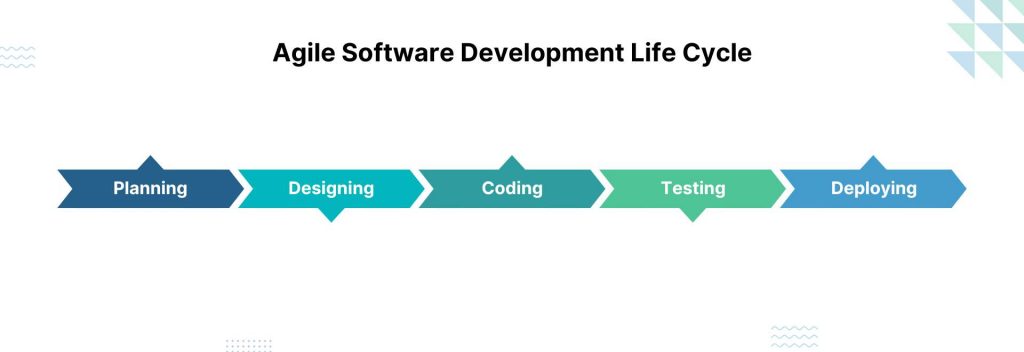Software development has evolved significantly over the years, and Agile Software Development stands at the forefront of this transformation. It’s a framework that has reshaped the way teams approach building software products, promoting flexibility, collaboration, and continuous improvement.
This comprehensive guide explores Agile Software Development, delving into its core principles, life cycle, methodologies, and the benefits it offers. Whether you’re a seasoned developer or a curious learner, this guide provides a clear understanding of Agile and its potential to drive success in software projects.
What is Agile Software Development?
Agile Software Development refers to a collection of methodologies designed to create software in a flexible, iterative, and incremental manner. The term “Agile” embodies adaptability and agility, emphasizing the importance of collaboration, customer feedback, adaptive planning, and continuous improvement. Agile methodologies are rooted in the Agile Manifesto, which lays out four key values and twelve principles that guide software development teams.
Core Principles
Agile principles prioritize customer satisfaction through early and continuous delivery of valuable software. This approach encourages welcoming changing requirements, even late in development, and delivers working software frequently. Agile promotes collaboration among stakeholders, developers, and customers, fostering a sense of shared responsibility. It values simplicity, self-organizing teams, and continuous reflection to improve processes and outcomes.
Agile Software Development Life Cycle

The Agile Software Development Life Cycle encompasses several iterative phases that allow teams to adapt and evolve based on feedback and changing requirements. Here’s an overview of the typical life cycle phases:
- Planning: Teams define project goals, gather requirements, and create a product backlog—a prioritized list of tasks and features.
- Designing: This phase involves creating design specifications, user stories, and architecture plans to guide development.
- Coding: Developers work in short iterations or “sprints,” typically lasting 1-4 weeks, to implement user stories and features.
- Testing: Continuous testing ensures that new code integrates smoothly and meets quality standards.
- Deploying: The software is deployed to production or staging environments, with feedback loops to address any issues.
Agile’s iterative approach distinguishes it from traditional development methods like Waterfall, where phases are linear and sequential. By embracing iteration, Agile allows teams to adapt quickly to changing requirements, leading to more efficient development and a shorter time-to-market.
Types of Agile Methodologies
Agile Software Development encompasses several methodologies and frameworks, each with unique characteristics and approaches. These methodologies share core Agile principles but may differ in terms of structure, roles, and practices. Here’s an overview of the most popular Agile methodologies:
- Scrum: Scrum is a widely used Agile framework with defined roles like Scrum Master, Product Owner, and Development Team. It emphasizes fixed-length iterations called sprints, daily stand-up meetings, and sprint reviews.
- Kanban: Kanban focuses on visualizing workflows using a Kanban board. It helps teams manage work in progress, identify bottlenecks, and maintain a steady flow of tasks.
- Extreme Programming (XP): XP emphasizes engineering practices like test-driven development (TDD), pair programming, and frequent releases. It promotes high-quality code and collaboration among developers.
- Lean: Lean principles center around eliminating waste and maximizing value. Lean encourages continuous improvement and efficiency in the development process.
- Other Agile Approaches: Additional methodologies include Crystal, which emphasizes team size and project criticality, and Dynamic Systems Development Method (DSDM), known for its focus on business collaboration.
Understanding these methodologies allows teams to choose the one that aligns best with their project goals and team dynamics. Each methodology has unique practices and techniques that can be adapted to fit specific needs and contexts.
Benefits of Agile Software Development
Agile offers numerous benefits to software development teams and stakeholders. These benefits contribute to Agile’s growing popularity in the software industry. Here are some key advantages:
- Improved Flexibility: Agile methodologies are designed to adapt to changing project requirements, providing flexibility in planning and execution.
- Increased Collaboration: Agile encourages close collaboration between developers, stakeholders, and customers, fostering better communication and alignment.
- Faster Time-to-Market: Agile’s iterative nature allows teams to deliver working software frequently, reducing time-to-market.
- Enhanced Product Quality: Continuous testing and feedback loops lead to higher-quality software, reducing the risk of defects in the final product.
- Greater Customer Satisfaction: Agile places a strong emphasis on customer involvement and feedback, ensuring that the end product meets customer needs.
Agile’s emphasis on adaptability and collaboration makes it a popular choice for software development projects of all sizes. However, while Agile offers significant advantages, it’s not without its challenges. It’s essential to consider the potential disadvantages and challenges. Here are some common disadvantages of Agile Software Development:
Potential Scope Creep: Agile’s flexibility can lead to scope creep if not managed carefully.
- Requires High Team Engagement: Agile demands active participation from team members and stakeholders.
- Might Not Suit All Projects: Agile is best suited for projects with evolving requirements and collaborative teams.
- Challenging for Large-Scale Projects: Agile can be complex for large-scale projects with multiple teams and stakeholders.
Despite these disadvantages, Agile remains a popular choice for software development due to its adaptability and customer-focused approach. The key to success with Agile lies in effective communication, clear project goals, and a commitment to continuous improvement.
How Can Agile Save You Money?
Agile methodologies can lead to significant cost savings for organizations, both in the short term and over the life of a project. Here are some of the ways Agile can help save money:
Reduced Rework
One of Agile’s primary benefits is its iterative approach to software development. Instead of building an entire product before testing, Agile promotes incremental development with frequent feedback loops. This means that defects and issues are identified and resolved early in the process, reducing the need for costly rework. By catching problems before they escalate, Agile prevents the waste of time and resources.
Better Resource Allocation
Agile emphasizes priority-driven work and sprint planning, ensuring that resources are allocated efficiently. Teams focus on delivering the most valuable features first, allowing for better utilization of time, effort, and budget. This approach prevents resources from being spent on low-priority tasks that may not add significant value.
Minimized Risk
Agile’s continuous feedback mechanism helps identify risks early in the project. By breaking down the project into manageable iterations, teams can address potential issues as they arise, mitigating the risk of project failure. This risk mitigation reduces the chances of costly project overruns or scope creep.
Alternative to Agile Software Development?
While Agile has gained widespread popularity, there are alternative approaches to software development that may be more suitable for specific projects. Here’s a brief overview of these alternatives:
Waterfall Methodology
The Waterfall methodology is a traditional approach to software development, characterized by a linear structure with distinct phases. Projects in Waterfall move sequentially through stages such as requirements gathering, design, implementation, testing, and deployment. Once a stage is completed, the project moves to the next stage, making it challenging to return and make changes.
When to Use Waterfall
Waterfall may be preferred when project requirements are clear, well-defined, and unlikely to change. It’s suitable for projects with strict deadlines or regulatory requirements, where a linear approach provides greater control and predictability. Waterfall is also common in industries like construction, where sequential phases are necessary due to the nature of the work.
Hybrid Approaches
Hybrid models, such as Agile-Waterfall, combine elements from both methodologies. These approaches aim to leverage the flexibility of Agile while maintaining the structure of Waterfall. Hybrid approaches are often used in large-scale projects with multiple teams, allowing for Agile practices within certain parts of the project while keeping other parts in a more linear structure.
How Have Other Organizations Successfully Adopted Agile?
Organizations worldwide have successfully adopted Agile methodologies, leading to significant improvements in project outcomes. Here’s a look at how some companies have benefited from Agile adoption:
Case Studies
Spotify
The music streaming giant Spotify has embraced Agile at scale, using a unique model that combines Agile principles with a strong emphasis on autonomy and innovation. Spotify’s approach to Agile has allowed it to adapt to changing market demands and maintain a competitive edge in the music streaming industry.
ING Bank
ING Bank, a global financial institution, implemented Agile across its entire organization. This transformation led to faster time-to-market for new products and improved collaboration across departments. ING’s Agile adoption has become a benchmark for other financial institutions looking to modernize their processes.
Key Success Factors
Successful Agile adoption often involves a combination of strong leadership, effective team training, and a commitment to Agile principles. Organizations that succeed with Agile typically invest in educating their teams about Agile practices and creating a culture that embraces change and continuous improvement. Leadership plays a crucial role in guiding the Agile transformation, ensuring that teams have the resources and support they need to succeed.
Lessons Learned
The experiences of organizations that have adopted Agile offer valuable lessons for others considering a similar transformation. Key lessons include the importance of communication, flexibility, and patience. Agile adoption can be challenging, especially for organizations with entrenched processes, but the benefits are worth the effort. Effective communication among team members and stakeholders is essential to align everyone with Agile principles and practices.
Conclusion
Agile Software Development provides a flexible, iterative, and collaborative approach to building software products. It offers significant cost savings, improved resource allocation, and enhanced risk management. While Agile has many advantages, it’s essential to understand its limitations and consider alternative approaches when necessary. Successful Agile adoption requires strong leadership, effective training, and a commitment to continuous improvement.
Have you experienced Agile Software Development in your projects? What were the benefits and challenges you encountered? Share your thoughts in the comments below!
We hope this blog has provided valuable insights. We encourage you to share your experiences or ask any questions you may have about Agile software development. Additionally, we invite you to explore more blogs at Ezeiatech. Let us know what other aspects of Agile software developement would you like to learn more about?







